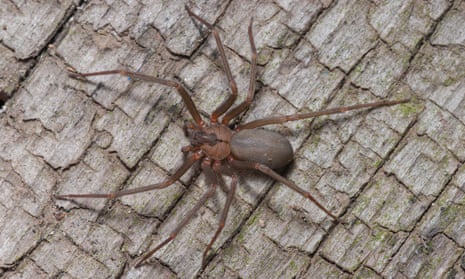A Kansas City woman woke one morning this week thinking she had water in her left ear. It turned out to be a highly venomous brown recluse spider.
Susie Torres told local TV station Fox 4 she “woke up [on] Tuesday hearing a bunch of swooshing and water in my left ear”. The sensation, she said, was “like when you went swimming”.
When she went to get her ears checked, she told KHSB, a medical assistant took a look then “ran out and said, ‘I’m going to get a couple more people.’
“She then said, ‘I think you have an insect in there.’”
It turned out to be an arachnid, about the size of a dime.
“They had a few tools and worked their magic and got it out,” Torres said.
The spider did not bite Torres during its time in her ear, which was lucky for her.
According to the US Centers for Disease Control and Prevention (CDC), the brown recluse, which is generally found in the US south and midwest, “cannot bite humans without some form of counter pressure, for example, through unintentional contact that traps the spider against the skin”.
But it adds: “The venom of a brown recluse can cause a severe lesion by destroying skin tissue (skin necrosis)” which “will require professional medical attention”.
The CDC says brown recluses, recognisable from violin-shaped markings on their heads, are “usually found in workplaces with secluded, dry, sheltered areas such as underneath structures [or] logs, or in piles of rocks or leaves.
“If a brown recluse spider wanders indoors, they may be found in dark closets, shoes, or attics.”
Hair-raising stories of people scared or bitten by brown recluses tend to attract press attention.
In 2015, a 40-year-old British man said his leg was left “bursting open” after a bite on a flight from Qatar to South Africa.
In 2018 another man told the Guardian how he nearly lost an arm after being bitten by a brown recluse hiding in a fruit bowl in London.
“I had both a dermonecrotic and systemic reaction,” Henry Moffett said, “meaning not only that the venom killed off skin and tissue but also my organs started to shut down as my blood thickened, which is rare and can be fatal.
“The doctors had to constantly put me under to open the back of my hand to cut away the flesh, trying to stop the venom and necrosis (the death of tissue cells) spreading further.”
“After two weeks in hospital,” Moffett added, “the doctor recommended amputating the arm up to the elbow because of the risk of necrosis spreading to my heart. I was adamant I’d rather have died.”
Moffett recovered, with the aid of a graft of skin from his thigh.
Torres told KHSB she was now taking precautions before going to bed.
“I went and put some cotton balls in my ear last night,” she said, “because I did not have any ear plugs. I’m pretty terrified of spiders.”
